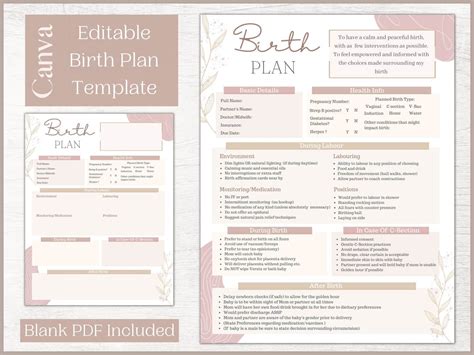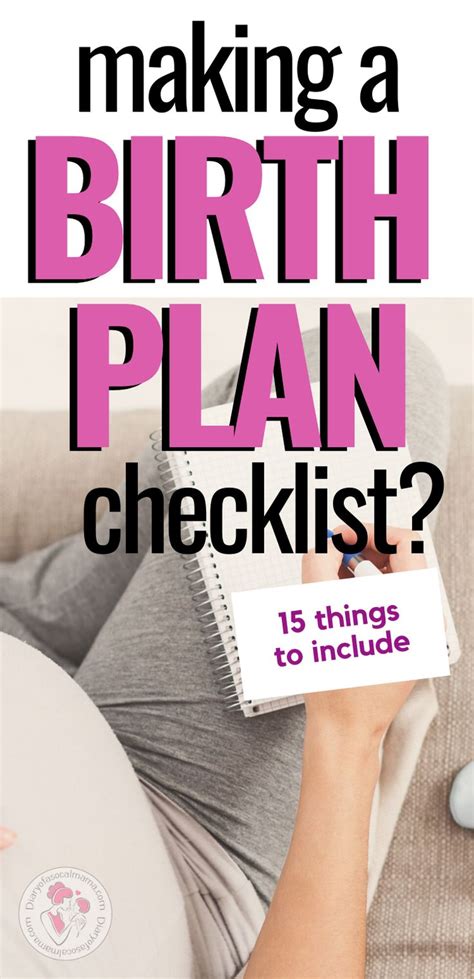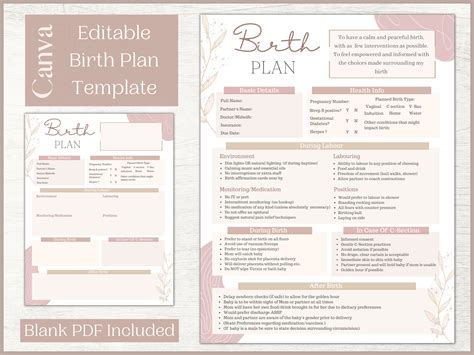Intro
Discover personalized birth plan examples, including natural labor, hospital, and home birth plans, to create a tailored childbirth experience with birth preferences, pain management, and postpartum care.
Having a birth plan is essential for expectant mothers as it outlines their preferences for the birth process, helping to ensure a more comfortable and empowering experience. A well-crafted birth plan can make a significant difference in the overall birthing experience, allowing mothers to feel more in control and prepared for the arrival of their baby. With a birth plan, expectant mothers can communicate their wishes to their healthcare provider, making it easier to navigate the birthing process. In this article, we will delve into the world of birth plans, exploring their importance, benefits, and providing examples to help expectant mothers create their own personalized plan.
The importance of having a birth plan cannot be overstated. It allows expectant mothers to take an active role in their care, making informed decisions about their body and their baby. A birth plan can help to reduce anxiety and stress, as mothers feel more prepared and in control of the birthing process. Moreover, a birth plan can help to facilitate communication between the mother and her healthcare provider, ensuring that everyone is on the same page. With a birth plan, expectant mothers can outline their preferences for pain management, labor positioning, and newborn care, among other things.
A birth plan is not a one-size-fits-all document; rather, it is a personalized outline of a mother's preferences and wishes for her birthing experience. It can include details such as the mother's preferred birthing position, whether she wants to use pain medication or not, and how she wants to manage the umbilical cord. A birth plan can also outline the mother's preferences for the baby's care after birth, including whether she wants to delay cord clamping, have skin-to-skin contact, or have the baby undergo any medical procedures. By having a birth plan in place, expectant mothers can ensure that their wishes are respected and that they receive the care they desire.
Understanding Birth Plans

Benefits of Birth Plans
The benefits of having a birth plan are numerous. For one, it allows expectant mothers to take an active role in their care, making informed decisions about their body and their baby. A birth plan can also help to reduce anxiety and stress, as mothers feel more prepared and in control of the birthing process. Additionally, a birth plan can help to facilitate communication between the mother and her healthcare provider, ensuring that everyone is on the same page. Some of the benefits of birth plans include: * Reduced anxiety and stress * Increased sense of control and empowerment * Improved communication with healthcare provider * Personalized care that meets the mother's unique needs and desires * Increased likelihood of a positive birthing experienceCreating a Birth Plan

Birth Plan Examples
Here are some examples of birth plans: * Example 1: Natural Birth Plan + Labor and delivery: Natural, unmedicated birth + Pain management: Breathing techniques, massage, and hydrotherapy + Birthing position: Upright, walking, and squatting + Newborn care: Delayed cord clamping, skin-to-skin contact, and breastfeeding * Example 2: Medicated Birth Plan + Labor and delivery: Medicated birth with epidural + Pain management: Epidural and breathing techniques + Birthing position: Lying down, sitting, and standing + Newborn care: Immediate cord clamping, skin-to-skin contact, and breastfeeding * Example 3: Cesarean Birth Plan + Labor and delivery: Cesarean section + Pain management: General anesthesia and breathing techniques + Birthing position: Lying down + Newborn care: Immediate cord clamping, skin-to-skin contact, and breastfeedingBirth Plan Templates

Sharing the Birth Plan
Once the birth plan has been created, it is essential to share it with the healthcare provider and support people. This can help to ensure that everyone is on the same page and that the mother's wishes are respected. Some ways to share the birth plan include: * Giving a copy to the healthcare provider * Discussing the birth plan with the healthcare provider * Sharing the birth plan with support people, such as partners and doulas * Bringing a copy of the birth plan to the hospital or birthing centerFlexibility and Birth Plans

Conclusion and Next Steps
In conclusion, having a birth plan is an essential part of preparing for the birthing experience. By outlining their preferences and wishes, expectant mothers can take an active role in their care, reduce anxiety and stress, and ensure a more comfortable and empowering experience. Whether using a birth plan template or creating a personalized plan from scratch, the key is to remain flexible and open-minded, and to prioritize the health and well-being of the mother and baby. By following these steps and considering the examples and templates provided, expectant mothers can create a birth plan that meets their unique needs and desires.What is a birth plan?
+A birth plan is a document that outlines a mother's preferences for her birthing experience. It is a personalized plan that takes into account the mother's unique needs, desires, and circumstances.
Why is having a birth plan important?
+HAVING a birth plan is important because it allows expectant mothers to take an active role in their care, making informed decisions about their body and their baby. It can also help to reduce anxiety and stress, and ensure a more comfortable and empowering experience.
How do I create a birth plan?
+Creating a birth plan involves considering the mother's unique needs, desires, and circumstances, as well as her preferences for the birthing experience. It can be created with the help of a healthcare provider, partner, or other support people.
What should I include in my birth plan?
+A birth plan should include details such as labor and delivery preferences, newborn care preferences, medical procedures, support people, and birth environment.
How do I share my birth plan with my healthcare provider?
+Sharing the birth plan with the healthcare provider can be done by giving them a copy, discussing the plan with them, or bringing a copy to the hospital or birthing center.
